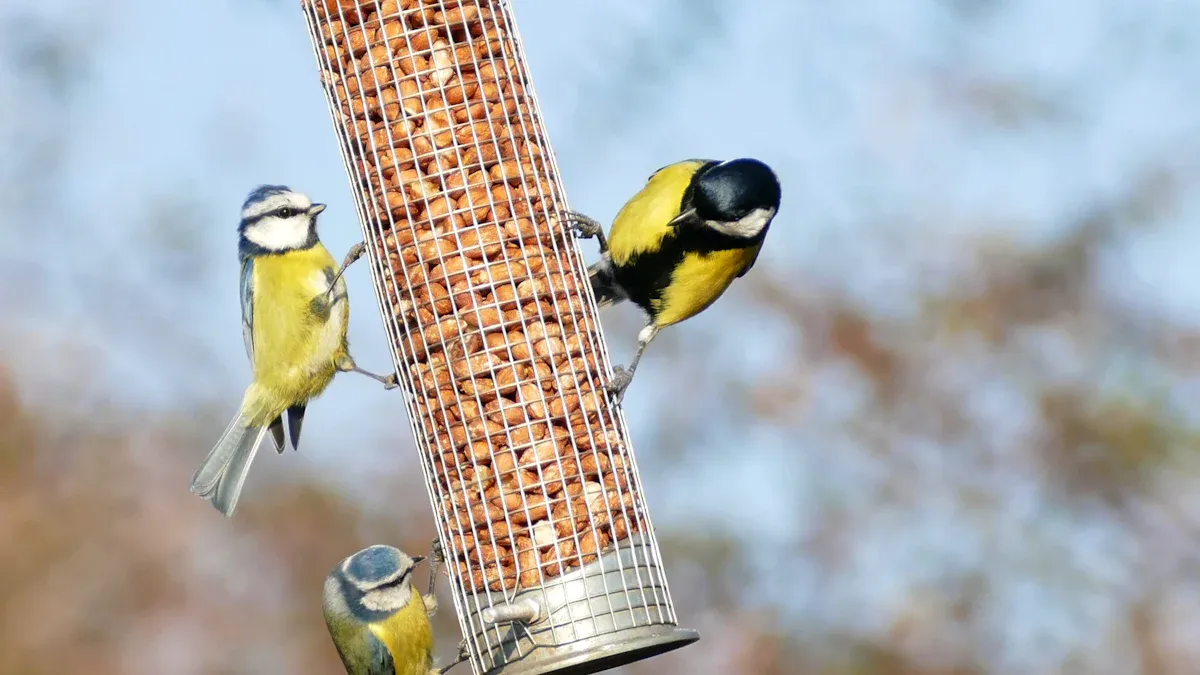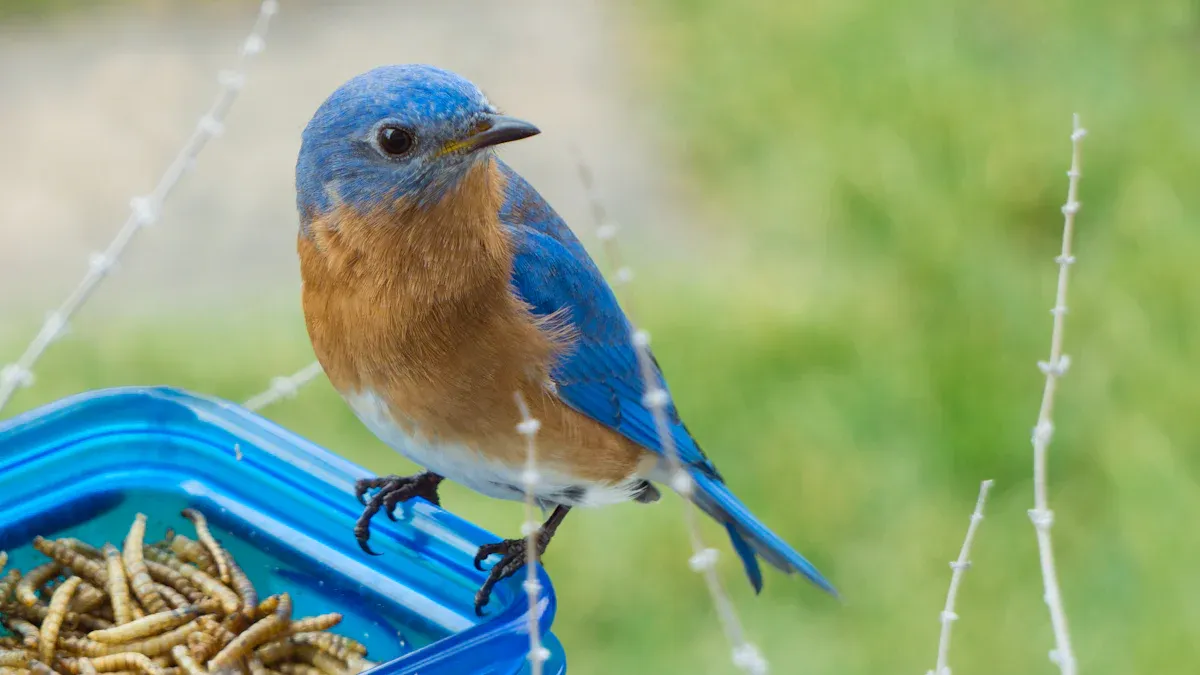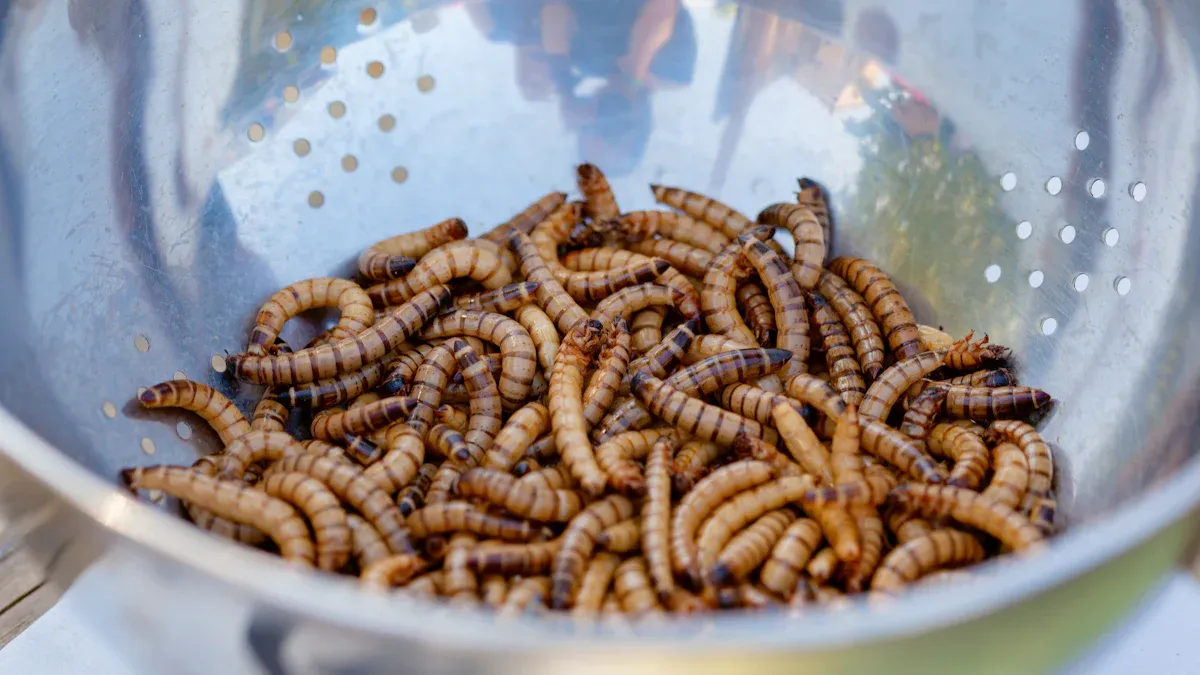
Dried mealworms offer a highly nutritious and appealing food source for birds. Packed with 53% protein, 28% lipid, and 8.5% carbohydrate, they support healthy growth and energy. Many bird rehabilitators enhance their nutritional value by coating them with specialized powders. Meal Worm Feed, sourced from trusted Mealworm Manufacturers, attracts a variety of bird species to any yard.
Key Takeaways
- Dried mealworms are healthy for birds. They give protein and energy.
- Adding mealworms to feeders brings many birds like robins and chickadees.
- Store and soak mealworms properly to keep them fresh for birds.
Benefits of Meal Worm Feed

Nutritional Value for Birds
Meal Worm Feed offers a powerhouse of nutrients that support bird health and vitality. Packed with essential components, mealworms contain approximately 51% protein, 19% lipid, and 18% non-fiber carbohydrates. These nutrients provide birds with the energy they need for daily activities like flying and foraging. Additionally, the 8% chitin content contributes to digestive health, while the 5% ash supplies vital minerals. This balanced nutritional profile makes mealworms an excellent choice for maintaining strong and active birds.
Birds benefit greatly from the high protein content, which aids in muscle development and feather growth. The lipid content provides a concentrated energy source, especially valuable during colder months when birds require extra calories to stay warm. By incorporating Meal Worm Feed into their diet, bird enthusiasts can ensure their feathered visitors receive a wholesome and satisfying meal.
Convenience and Storage Advantages
Dried mealworms offer unmatched convenience compared to live alternatives. They require no maintenance, eliminating the need for refrigeration or feeding. Unlike live mealworms, they are mess-free and easy to handle. Bird lovers can store dried mealworms for extended periods by keeping them sealed in a cool, dry place. This long shelf life makes them a practical and economical option for year-round bird feeding.
Meal Worm Feed simplifies the feeding process. It can be mixed with other bird seeds or served alone, making it versatile for different feeding setups. With minimal effort, bird enthusiasts can enjoy the sight of vibrant and healthy birds flocking to their yards.
Birds That Love Meal Worm Feed

Common Backyard Birds
Meal Worm Feed attracts a wide variety of common backyard birds. Chickadees, Red-breasted Nuthatches, and White-breasted Nuthatches are frequent visitors to feeders offering this nutritious treat. Robins, known for their love of insects, also enjoy mealworms. These birds benefit from the high protein content, which supports their energy needs and overall health.
Tip: Offering mealworms in small quantities can make them even more appealing to wild birds. This approach works especially well during spring when birds are feeding their young.
Adding mealworms to feeders creates an inviting environment for these species. Bird enthusiasts often observe increased activity and diversity in their yards after introducing this feed. The sight of these vibrant birds enjoying their mealworms adds joy to any birdwatching experience.
Seasonal Variations in Bird Species
Different seasons bring unique bird species to feeders. During spring and summer, insect-eating birds like robins and nuthatches actively seek mealworms to feed their chicks. In fall and winter, birds such as chickadees rely on mealworms for the extra energy needed to survive colder temperatures.
Meal Worm Feed serves as a reliable food source throughout the year. Its versatility ensures that bird enthusiasts can attract a variety of species, regardless of the season. By observing seasonal patterns, they can adjust feeding practices to cater to the needs of visiting birds.
How to Use Meal Worm Feed
Choosing the Right Feeder
Selecting the appropriate feeder ensures birds can access Meal Worm Feed easily and safely. Hopper feeders, tray feeders, and specialized mealworm feeders work well for dried mealworms. Feeder designs with tall sides prevent mealworms from escaping, while deep ledges keep them contained. Adding a roof or baffle protects the feed from rain, maintaining its freshness. Drainage holes are essential to prevent mold and water accumulation.
Birds prefer feeders with clear visibility to monitor for predators. Placing feeders near shrubs or trees provides birds with quick access to cover, enhancing their sense of security. Tamper-resistant features deter squirrels and other pests, ensuring the feed remains available for birds.
Mixing Mealworms with Other Bird Feed
Combining mealworms with other bird feed creates a balanced and appealing mix for a variety of species. Mixing dried mealworms with seeds, nuts, or suet increases the nutritional diversity of the feed. Finer feed particles, such as crushed seeds, improve digestion and nutrient absorption for birds. A blend of dry and moist feed ensures hydration without risking mold.
Bird enthusiasts can experiment with ratios to find the most effective mix for their local bird population. Offering mealworms alongside traditional feed encourages birds to try this nutritious option, gradually increasing their preference for Meal Worm Feed.
Placement of Feeders
Strategic feeder placement maximizes bird attraction and ensures safety. Position feeders in areas sheltered from rain to keep mealworms dry. Birds favor locations with a clear line of sight to detect predators. Proximity to vegetative cover, such as shrubs or trees, provides birds with a quick escape route.
Avoid placing feeders too close to windows to prevent collisions. Elevated feeders with tamper-resistant features deter squirrels and other pests. Regularly check feeders for cleanliness and functionality to maintain an inviting feeding environment.
Tips for Success with Meal Worm Feed
Hydrating Mealworms for Added Appeal
Hydrating dried mealworms can make them more appealing to birds. Slightly moistening the mealworms enhances their texture and flavor, mimicking the qualities of live insects. Birds like chickadees often prefer fresh or hydrated mealworms over dried ones. To hydrate mealworms, soak them in warm water for a few minutes before placing them in the feeder. Avoid leaving damp mealworms out for more than two days to prevent spoilage.
Tip: Offering both hydrated and dry mealworms allows birds to choose their preferred option, increasing the likelihood of attracting a variety of species.
Keeping Mealworms Fresh and Pest-Free
Proper storage is essential to maintain the freshness of Meal Worm Feed and to keep pests away. Dried mealworms should be stored in a sealed container in a cool, dry place. This prevents moisture from causing mold and keeps pests like ants or rodents at bay. For live mealworms, refrigeration slows their development and prevents them from maturing into pupae.
Feeders with tall sides, roofs, and drainage holes protect mealworms from rain and pests. Regularly clean feeders to remove debris and prevent contamination. These practices ensure the mealworms remain safe and nutritious for birds.
Observing Bird Behavior
Bird behavior around mealworm feeders can provide valuable insights. Birds may take time to recognize mealworms as food, especially if they are not moving. Once they associate the feeder with mealworms, they will return frequently. Increased activity and competition often occur during nesting seasons when birds feed their young.
Setting out multiple feeders reduces competition and allows more birds to enjoy the mealworms. Observing caching behaviors, such as chickadees storing mealworms for later, highlights the importance of providing a consistent food source.
Meal Worm Feed offers a simple way to attract a variety of birds while supporting their health and energy needs. Its nutritional benefits and ease of use make it an excellent addition to any bird-feeding routine. By incorporating mealworms, bird enthusiasts can enjoy a more vibrant and active bird population in their yards.
FAQ
What types of birds are most attracted to mealworms?
Birds like chickadees, robins, bluebirds, and nuthatches love mealworms. These species enjoy the high protein content, which supports their energy needs and overall health. 🐦
Can mealworms be used year-round?
Yes, mealworms work well in every season. Birds rely on them for energy during winter and use them to feed their chicks in spring and summer.
How should mealworms be stored to keep them fresh?
Store dried mealworms in a sealed container in a cool, dry place. This prevents moisture, mold, and pests, ensuring they remain safe and nutritious for birds.


